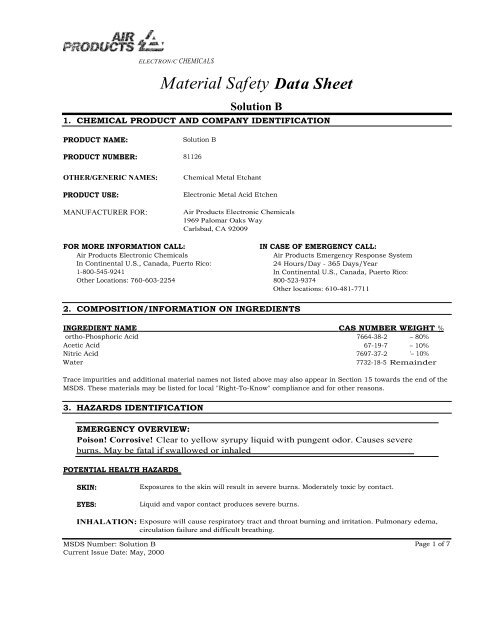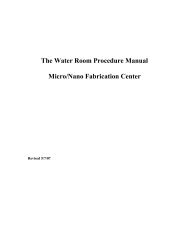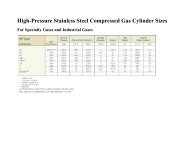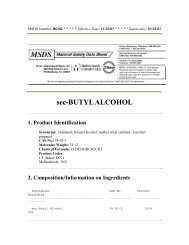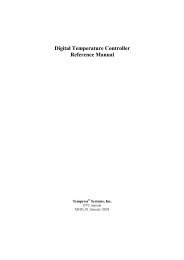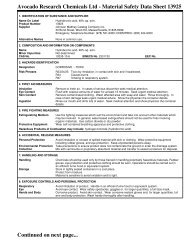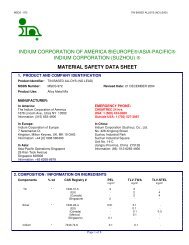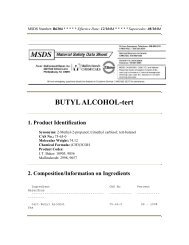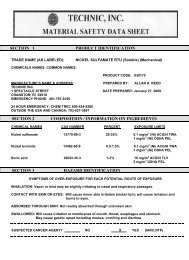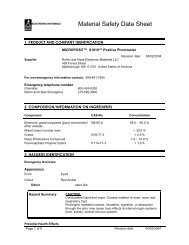Material Safety Data Sheet Solution B
Material Safety Data Sheet Solution B
Material Safety Data Sheet Solution B
Create successful ePaper yourself
Turn your PDF publications into a flip-book with our unique Google optimized e-Paper software.
ELECTRON/C CHEMICALS<br />
<strong>Material</strong> <strong>Safety</strong> <strong>Data</strong> <strong>Sheet</strong><br />
<strong>Solution</strong> B<br />
1. CHEMICAL PRODUCT AND COMPANY IDENTIFICATION<br />
PRODUCT NAME: <strong>Solution</strong> B<br />
PRODUCT NUMBER: 81126<br />
OTHER/GENERIC NAMES: Chemical Metal Etchant<br />
PRODUCT USE: Electronic Metal Acid Etchen<br />
MANUFACTURER FOR: Air Products Electronic Chemicals<br />
1969 Palomar Oaks Way<br />
Carlsbad, CA 92009<br />
FOR MORE INFORMATION CALL: IN CASE OF EMERGENCY CALL:<br />
Air Products Electronic Chemicals Air Products Emergency Response System<br />
In Continental U.S., Canada, Puerto Rico: 24 Hours/Day - 365 Days/Year<br />
1-800-545-9241 In Continental U.S., Canada, Puerto Rico:<br />
Other Locations: 760-603-2254 800-523-9374<br />
Other locations: 610-481-7711<br />
2. COMPOSITION/INFORMATION ON INGREDIENTS<br />
INGREDIENT NAME CAS NUMBER WEIGHT %<br />
ortho-Phosphoric Acid 7664-38-2 – 80%<br />
Acetic Acid 67-19-7 – 10%<br />
Nitric Acid 7697-37-2 '– 10%<br />
Water 7732-18-5 Remainder<br />
Trace impurities and additional material names not listed above may also appear in Section 15 towards the end of the<br />
MSDS. These materials may be listed for local "Right-To-Know" compliance and for other reasons.<br />
3. HAZARDS IDENTIFICATION<br />
EMERGENCY OVERVIEW:<br />
Poison! Corrosive! Clear to yellow syrupy liquid with pungent odor. Causes severe<br />
burns. May be fatal if swallowed or inhaled<br />
POTENTIAL HEALTH HAZARDS<br />
SKIN:<br />
Exposures to the skin will result in severe burns. Moderately toxic by contact.<br />
EYES: Liquid and vapor contact produces severe burns.<br />
INHALATION: Exposure will cause respiratory tract and throat burning and irritation. Pulmonary edema,<br />
circulation failure and difficult breathing.<br />
MSDS Number: <strong>Solution</strong> B Page 1 of 7<br />
Current Issue Date: May, 2000
ELECTRONIC CHEMICALS<br />
<strong>Material</strong> <strong>Safety</strong> <strong>Data</strong> <strong>Sheet</strong><br />
<strong>Solution</strong> B<br />
INGESTION: Is harmful and may be fatal. Severe burns to month, throat and stomach, also nausea and<br />
vomiting.<br />
DELAYED EFFECTS: Not Applicable<br />
Ingredients that are found on one of the OSHA designated carcinogen lists are listed below.<br />
INGREDIENT NAME<br />
No ingredients listed in this section.<br />
4. FIRST AID MEASURES<br />
NTP STATUS IARC STATUS OSHA LIST<br />
SKIN: Flush with water for at least 15 minutes while remove contaminated clothing and shoes.<br />
Wash clothing before reuse.<br />
EYES: Flush with water for at least 15 minutes. Get medical assistance.<br />
INHALATION: Remove to fresh air. If breathing is difficult, give oxygen if qualified personnel are available.<br />
Call a physician immediately.<br />
INGESTION: Get immediate medical attention! If patient is conscious, rinse mouth with water. Do not<br />
induce vomiting unless instructed to do so by a physician..<br />
ADVICE TO PHYSICIAN: No specific instructions. Treat symptomatically.<br />
5. FIRE FIGHTING MEASURES<br />
FLAMMABLE PROPERTIES<br />
FLASH POINT:<br />
FLASH POINT METHOD:<br />
AUTOIGNITION TEMPERATURE:<br />
LOWER FLAME LIMIT (volume % in air):<br />
UPPER FLAME LIMIT (volume % in air):<br />
FLAME PROPAGATION RATE (solids):<br />
OSHA FLAMMABILITY CLASS:<br />
Does Not Burn<br />
Not applicable<br />
Not applicable<br />
Not applicable<br />
Not applicable<br />
Not applicable<br />
Not applicable<br />
EXTINGUISHING MEDIA:<br />
Use extinguishing media appropriate for surrounding fire.<br />
UNUSUAL FIRE AND EXPLOSION HAZARDS:<br />
May emit toxic fumes of POx gas if heated to decomposition.<br />
SPECIAL FIRE FIGHTING PRECAUTIONS/INSTRUCTIONS:<br />
Wear self-contained positive pressure breathing apparatus. Do not release runoff from fire control methods to<br />
sewers or waterways. Keep fire exposed containers cool with water spray. Do not get water inside containers.<br />
MSDS Number: <strong>Solution</strong> B Page 2 of 7<br />
Current Issue Date: May, 2000
AIR<br />
'ZOO CTS<br />
y<br />
ELECTRONIC CHEMICALS<br />
6. ACCIDENTAL RELEASE MEASURES<br />
<strong>Material</strong> <strong>Safety</strong> <strong>Data</strong> <strong>Sheet</strong><br />
<strong>Solution</strong> B<br />
IN CASES OF SPILL OR OTHER RELEASE: (Always wear recommended personal protective equipment.)<br />
Remove personnel from area. Neutralize spill with chalk and pick-up with absorbent material. Dispose of<br />
according to Federal and/or local regulations.<br />
Spills and releases may have to be reported to Federal and/or local authorities. See Section 15 regarding reporting<br />
requirements.<br />
7. HANDLING AND STORAGE<br />
NORMAL HANDLING: (Always wear recommended personal protective equipment.)<br />
Keep container tightly closed. Use good personal hygiene and housekeeping practices.<br />
STORAGE RECOMMENDATIONS:<br />
Protect from physical damage. Store in a cool, dry, corrosion-proof area. Isolate from incompatible materials.<br />
8. EXPOSURE CONTROLS/PERSONAL PROTECTION<br />
ENGINEERING CONTROLS:<br />
Provide general or local exhaust ventilation systems to maintain airborne concentrations below permissible TLV<br />
levels. Local exhaust ventilation is preferred because it prevents contaminant dispersion into the work area by<br />
controlling it at its source.<br />
PERSONAL PROTECTIVE EQUIPMENT<br />
SKIN PROTECTION:<br />
Acid resistant protective gloves and clothing if there is repeated or prolonged exposure to liquid or mist.<br />
Otherwise, full work clothing. Acceptable materials of construction include: neoprene, rubber, nitrile, and vinyl.<br />
EYE PROTECTION:<br />
Goggles and face shields are considered minimum protection. Do not wear contacts.<br />
RESPIRATORY PROTECTION:<br />
Use NIOSH approved acid gas cartridge respirator. Chemical cartridge respirators do not supply oxygen. In the<br />
event of a spill or emergency, use NIOSH approved self-contained breathing apparatus (SCBA).<br />
ADDITIONAL RECOMMENDATIONS:<br />
Eyewash and quick-drench safety shower facilities, protect from freezing, should be available where acids are<br />
stored or handled.<br />
MSDS Number: <strong>Solution</strong> B Page 3 of 7<br />
Current Issue Date: May, 2000
EXPOSURE GUIDELINES<br />
ELECTRONIC CHEMICALS<br />
<strong>Material</strong> <strong>Safety</strong> <strong>Data</strong> <strong>Sheet</strong><br />
<strong>Solution</strong> B<br />
INGREDIENT NAME ACGIH TLV OSHA PEL OTHER LIMIT<br />
Phosphoric Acid 1 mg/m 3 TWA 1 mg/m 3 TWA None<br />
3 mg/m 3 STEL<br />
Acetic Acid 10 ppm TWA 10 PPM TWA None<br />
15 PPM STEL<br />
Nitric Acid 2 ppm TWA 2 ppm TWA None<br />
4 ppm STEL<br />
= Workplace Envirorunental Exposure Level (AIHA).<br />
= Biological Exposure Index (ACGIH).<br />
OTHER EXPOSURE LIMITS FOR POTENTIAL DECOMPOSITION PRODUCTS:<br />
None<br />
9. PHYSICAL AND CHEMICAL PROPERTIES<br />
APPEARANCE: Clear to yellow, syrupy liquid.<br />
PHYSICAL STATE: Liquid<br />
MOLECULAR WEIGHT: Mixture<br />
CHEMICAL FORMULA: Mixture<br />
ODOR: Pungent odor<br />
SPECIFIC GRAVITY (water = 1.0): Mixture<br />
SOLUBILITY IN WATER (weight %): Complete<br />
pH:<br />
BOILING POINT: > 212°F (100°C)<br />
FREEZING POINT: Not applicable<br />
VAPOR PRESSURE: @ 20°C Not applicable<br />
VAPOR DENSITY (air = 1.0): Not applicable<br />
EVAPORATION RATE: Not applicable<br />
VOLATILES: Not applicable<br />
FLASH POINT: Not applicable<br />
(Flash point method and additional flammability data are found in section 5.)<br />
10. STABILITY AND REACTIVITY<br />
NORMALLY STABLE? (CONDITIONS TO AVOID):<br />
Stable at room temperatures. Avoid contact with heat and moisture sources.<br />
INCOMPATIBILITIES:<br />
Most common metals, and strong alkalizes. Potentially violent reaction with sodium tetrahydroborate.<br />
HAZARDOUS DECOMPOSITION PRODUCTS:<br />
Combustion by products includes oxides of phosphorus.<br />
MSDS Number: <strong>Solution</strong> B Page 4 of 7<br />
Current Issue Date: May, 2000
A<br />
erS ; I ' -.1.<br />
ELECTRONIC CHEMICALS<br />
HAZARDOUS POLYMERIZATION:<br />
Will not occur.<br />
<strong>Material</strong> <strong>Safety</strong> <strong>Data</strong> <strong>Sheet</strong><br />
<strong>Solution</strong> B<br />
11.TOXICOLOGICAL INFORMATION<br />
Phosphoric Acid<br />
IMMEDIATE (ACUTE) EFFECTS:<br />
Oral LD 50 (rat): 1530 mg/kg<br />
Eye Irritation (rabbit): 119 mg - severe irritation effects<br />
Skin Irritation (rabbit): 595 mg/24H - severe irritation effects<br />
Acetic Acid<br />
IMMEDIATE (ACUTE) EFFECTS:<br />
Oral LD 50 (rat): 3310 mg/kg<br />
Inhalation LC50 (rat): 5620 ppm, 1 hour<br />
Eye Irritation LD50 (rabbit): 1.06 g/kg Strong<br />
Nitric Acid<br />
IMMEDIATE (ACUTE) EFFECTS:<br />
Oral LD50 (rat): Limited data<br />
Inhalation LCso (rat): 65 ppm, 4 hour<br />
Eye Irritation (rabbit): -100 mg - Strong<br />
DELAYED (SUBCHRONIC AND CHRONIC) EFFECTS:<br />
None<br />
OTHER DATA:<br />
None<br />
12.ECOLOGICAL INFORMATION<br />
None known.<br />
13.DISPOSAL CONSIDERATIONS<br />
RCRA<br />
Is the unused product a RCRA hazardous waste if discarded? Yes<br />
If yes, the RCRA ID number is: D002 Corrosive<br />
OTHER DISPOSAL CONSIDERATIONS:<br />
Disposer must comply with Federal, State and Local disposal or discharge laws.<br />
The information offered here is for the product as shipped. Use and/or alterations to the product such as mixing<br />
with other materials may significantly change the characteristics of the material and alter the RCRA classification and<br />
the proper disposal method.<br />
MSDS Number: <strong>Solution</strong> B Page 5 of 7<br />
Current Issue Date: May, 2000
-DUCTS<br />
ELECTRONIC CHEMICALS<br />
<strong>Material</strong> <strong>Safety</strong> <strong>Data</strong> <strong>Sheet</strong><br />
<strong>Solution</strong> B<br />
14.TRANSPORT INFORMATION<br />
US DOT PROPER SHIPPING NAME: Corrosive liquid n.o.s. (Phosphoric acid and acetic acid)<br />
US DOT HAZARD CLASS: 8 , Corrosive<br />
US DOT ID NUMBER: UN1760<br />
US DOT PACKING GROUP: II<br />
NA EMERGENCY RESPONSE GUIDE: 154<br />
For additional information on shipping regulations affecting this material, contact the information number found in<br />
Section 1.<br />
15.REGULATORY INFORMATION<br />
TOXIC SUBSTANCES CONTROL ACT (TSCA)<br />
TSCA INVENTORY STATUS: Listed on the inventory.<br />
OTHER TSCA ISSUES: Not subject to export notification.<br />
SARA TITLE IIVCERCLA<br />
"Reportable Quantities" (RQs) and/or "Threshold Planning Quantities" (TPQs) exist for the following ingredients.<br />
INGREDIENT NAME SARA/CERCLA RQ (lb) SARA EHS TPQ (lb)<br />
Phosphoric Acid 5,000 None<br />
Acetic Acid 5,000 None<br />
Nitric Acid 1,000 1,000 (vapor)<br />
Spills or releases resulting in the loss of any ingredient at or above its RQ requires immediate notification to<br />
the National Response Center [(800) 424-8802] and to your Local Emergency Planning Committee.<br />
SECTION 311 HAZARD CLASS: Immediate<br />
Reactive<br />
SARA 313 TOXIC CHEMICALS:<br />
The following ingredients are SARA 313 "Toxic Chemicals". CAS numbers and weight percents are found in<br />
Section 2.<br />
INGREDIENT NAME COMMENT<br />
Phosphoric Acid 1%<br />
Nitric Acid 1%<br />
STATE RIGHT-TO-KNOW<br />
In addition to the ingredients found in Section 2, the following are listed for state right-to-know purposes.<br />
INGREDIENT NAME WEIGHT % COMMENT<br />
No ingredients listed in this section<br />
MSDS Number: <strong>Solution</strong> B Page 6 of 7<br />
Current Issue Date: May, 2000
ELECTRONIC CHEMICALS<br />
ADDITIONAL REGULATORY INFORMATION:<br />
None<br />
WHMIS CLASSIFICATION (CANADA):<br />
Class E<br />
FOREIGN INVENTORY STATUS:<br />
Listed on the Canadian DSL and EINECS<br />
16. OTHER INFORMATION<br />
CURRENT ISSUE DATE: May 2000<br />
PREVIOUS ISSUE DATE: New<br />
<strong>Material</strong> <strong>Safety</strong> <strong>Data</strong> <strong>Sheet</strong><br />
<strong>Solution</strong> B<br />
CHANGES TO MSDS FROM PREVIOUS ISSUE DATE ARE DUE TO THE FOLLOWING:<br />
New<br />
OTHER INFORMATION: NFPA Classification: Health - 3<br />
Flammability - 0<br />
Reactivity - 0<br />
MSDS Number: <strong>Solution</strong> B Page 7 of 7<br />
Current Issue Date: May, 2000


